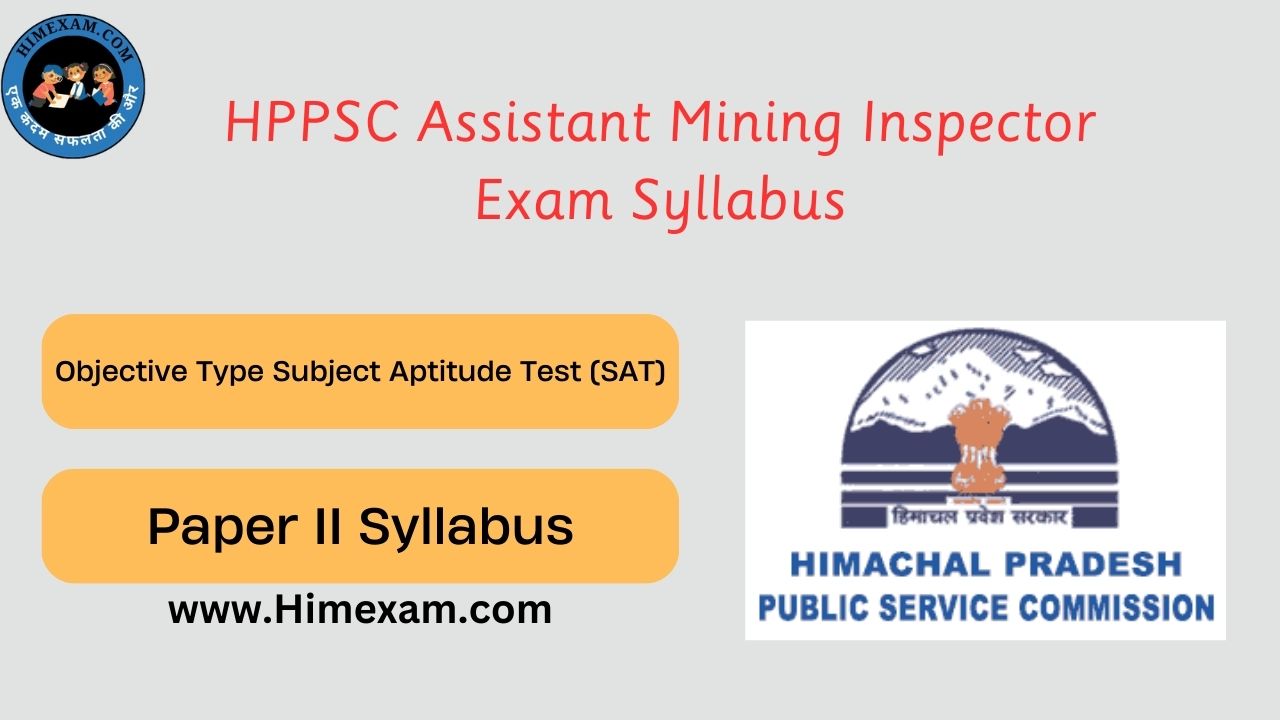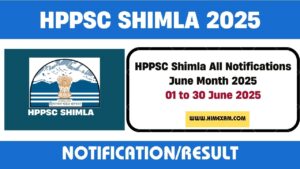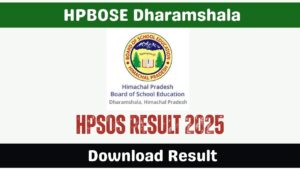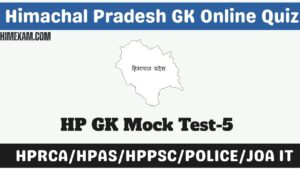Table of Contents
ToggleHPPSC Assistant Mining Inspector Objective Type Subject Aptitude Test (SAT) Exam Syllabus (PAPER-II)
Syllabus for Paper-II i.e. Objective Type Subject Aptitude Test (SAT) for recruitment to the posts of Assistant Mining Inspector, Class-III (on contract basis) in the Directorate of Industries, H.P. The SAT shall be of 02 hours duration having 100 marks as follows:-
Physics & Chemistry of 10+2 level (100 marks) (50+50 marks)
1. ELECTROSTATICS: Electric Charges; Conservation of charge, Coulomb’s law, force between two point charges, forces between multiple charges; superposition principle and continuous charge distribution, Electric field, electric field due to a point charge, electric field lines, electric dipole, electric field due to a dipole; torque on a dipole in uniform electric field, Electric flux, statement of Gauss’s theorem and its applications to find field due to infinitely long straight wire, uniformly charged infinite plans sheet and uniformly charged thin spherical shell (field inside and outside), Electric potential, potential difference, electric potential due to a point charge, a dipole and system of charges; equipotential surfaces, electrical potential energy of a system of two point charges and of electric dipole in an electrostatic field, Conductors and insulators, free charges and bound charges inside a conductor; Dielectrics and electric polarization, capacitor and capacitance, combination of capacitors in series and in parallel, capacitance of a parallel plate capacitor with and without dielectric medium between the plates; energy stored in a capacitor. Van de Graaff generator.
2. CURRENT ELECTRICITY: Electric current, the flow of electric charges in a metallic conductor, drift velocity and mobility, and their relation with electric current; Ohm’s law, electrical resistance, V-I characteristics, (linear and non-linear) electrical energy and power, electrical resistivity and conductivity, Carbon resistors, colour code for carbon resistors; series and parallel combinations of resistors; temperature dependence of resistance, Internal resistance of a cell, Potential difference and emf of a cell, the combination of cells in series and parallel, Kirchhoff’s laws and simple applications, Wheatstone bridge, Metre bridge, Potentiometerprinciple and its applications to measure potential difference, and for comparing emf of two cells; measurement of internal resistance of a cell.
3. MAGNETIC EFFECT OF CURRENT AND MAGNETISM: Concept of the magnetic field, Oersted’sexperiment, Biot-Savartlaw, and its application to current carrying circular loop, Ampere’s law and its applications to infinitely long straight wire, straight and tropical solenoids. Force on a moving charge in uniform magnetic and electric fields Cyclotron, Force on a moving charge in uniform magnetic and electric fields Cyclotron, Force on a current-carrying conductor in a uniform magnetic field, Force between two parallel current-carrying conductors-definition of ampere. Torque experienced by a current loop in the uniform magnetic field; moving coil galvanometer-its current sensitivity and conversion to ammeter and voltmeter, Current loop as a magnetic dipole and its magnetic dipole moment; Magnetic dipole moment of a revolving electron; Magnetic field intensity due to a magnetic dipole (bar magnet) along its axis and perpendicular to its axis. Torque on a magnetic dipole (bar magnet) in a uniform magnetic field; bar magnet as an equivalent solenoid, magnetic field lines; Earth’s magnetic field and magnetic elements; Para-, dia- and ferro-magnetic substances with examples, Electromagnets and factors affecting their strengths permanent magnets.
4. ELECTROMAGNETIC INDUCTIONS AND ALTERNATING CURRENT: Electromagnetic induction, Faraday’s laws, Induced emf and current, Lenz’s law, Eddy currents, Self and mutual inductance, Need for displacement current, Alternating currents, peak and RMS value of alternating current/voltage, reactance and impedance; LC oscillations, (qualitative treatment only), LCR series circuit, resonance; Power in AC circuits, wattles current, AC generator and transformer.
5. ELECTROMAGNETIC WAVES: Electromagnetic waves and their characteristics (qualitative ideas only); Transverse nature of electromagnetic waves, Electromagnetic spectrum (radiowaves, microwaves, infrared, visible, ultraviolet, X-rays, gamma rays) including elementary facts about their uses.
6. OPTICS: Reflections of light, spherical mirrors, mirror formula. Refraction of light total internal reflection and its applications, optical fibers, refraction at spherical surfaces, lenses, thin lens formula, lens-maker’s formula. Magnification, power of a lens, the combination of thin lenses in contact, Refraction and dispersion of light through a prism, scattering of light to explain blue colour of the sky and reddish appearance of the sun at sunrise and sunset, Optical instruments – Human eye, image formation and accommodation, correction of eye defects (myopia, hypermetropia, presbyopia and astigmatism) using lenses. Microscopes and astronomical telescopes (reflection and refraction) and their magnifying powers, Wave Optics – Wave front and Huygen’s principle; reflection and refraction of plane wave at a plane surgace using wavefronts. Reflection and refraction using Huygen’s principle, Interference- Young’s double slit experiment and expression for fringe width, coherent sources, and sustained interference of light. Diffraction due to a single slit, width of central maximum, Resolving power of microscopes and astronomical telescopes. Polarisation, plane polarized light, Brewster’s Law; uses of plane Polarized light and Polaroid.
7. DUAL NATURE OF MATTER AND RADIATION: Dual nature of radiation. Photoelectric effect, Hertzand Lenard’s observation; Einstein’s photoelectric equation-particle nature of light, Matter waves–wave nature of particles, de-Broglie relation, Davisson Germer experiment.
8. ATOMIC AND NUCLEI: Alpha-particle scattering experiment, Rutherford’s model of atom; Bohr model, energy levels, hydrogen spectrum, Composition and size of nucleus, atomic masses, isotopes, isobars, isotones, Radioactivity- alpha, beta, and gamma particles/rays and their properties; radioactive decay law, Mass-energy relation, mass defect, the binding energy per nucleon and its variation with mass number, nuclear fission and fusion.
9. ELECTRONIC DEVICES: Semiconductors; Semiconductor diode, -I-V characteristics in forward and reverse bias, diode asa rectifier; I-V characteristics of LED, photodiode, solar cell, and Zener diode; Zener diode as a voltage regulator, Junction transistor, transistor action, characteristics of transistor; transistors an amplifier (common emitter configuration) and oscillator. Logic gates (OR, AND, NOT, NAND, and NOR): Transistor as a switch.
10. COMMUNICATION SYSTEMS: Elements of communication systems (block diagram only); bandwidth of signals (speech, TV and digital data); bandwidth of transmission medium, Propagation of electromagnetic waves in the atmosphere, sky and space wave propagation. Need for modulation, Production and detection of an amplitude-modulated wave.
11. SOLID STATE:Classification of Solids based on different binding forces: molecular, ionic covalent and metallicsolids, amorphous and crystalline solids (elementary idea), unit cell in twodimensional andthree-dimensional lattices, calculation of density of unit cell,packing in solids, voids, number ofatomsperunitcellinacubicunit cell,pointdefects,electricaland magneticproperties.
12. SOLUTIONS:Types of solutions, expression of concentration of solutions of solids in liquids, solubility of gases in liquids, solid solutions, colligative properties-relative lowering of vapor pressure, elevation of B.P. depression of freezing point, osmotic pressure, determination of molecular masses using colligative properties, abnormal molecular mass.
13. ELECTROCHEMISTRY:Redox reactions, conductance in electrolytic solutions, specific and molar conductivity variations of conductivity with concentration, Kohlrausch’s Law, electrolysis and laws of electrolysis (elementary idea), dry cell. Electrolytic cells and Galvanic cells; lead accumulator, EMF of a cell standard electrode potential, Nernst equation and its application to chemical cells, fuelcells; corrosion.
14. CHEMICAL KINETICS: Rate of a reaction (average and instantaneous), factors affecting rates of reaction; concentration, temperature, catalyst; order and molecularity of a reaction; rate law and specificrate constant, integrated rate equations and half life (only for zero and first order reactions); the concept of collision theory (elementary idea, no mathematical treatment).
15. SURFACE CHEMISTRY: Adsorption-physisorption and chemisorptions factors affecting adsorption of gases of solids; catalysis: homogenous and heterogeneous activity and selectivity : enzyme catalysis; colloidal state: distinction between true solutions colloids and suspensions; lyophilic, lyophobic multimolecular, and macromolecular colloids; properties of colloids; Tyndall effect, Brownian movement, electrophoresis, coagulation; emulsion-types of emulsions.
16. GENERAL PRINCIPLES & PROCESSES OF ISOLATION OF ELEMENTS: Principles and methods of extraction-concentration, oxidation, reduction, electrolytic method and refining; occurrence and principles of extraction of aluminum, copper, zincand Iron.
17. P-BLOCK ELEMENTS: Group 15 Elements: General introduction, electronic configuration, occurance oxidation states, trends in physical and chemical properties; nitrogen-preparation, properties and uses: compounds of nitrogen; preparation, properties of ammonia and nitric acid, oxides of nitrogen(structure only); Phosphorous-allotropic forms: compounds of phosphorous: preparation and properties of phosphine, halides (PCl3,PCl5) and oxoacids (elementary idea only), Group 16 Elements: General introduction, electronic configuration, oxidation states, occurrence, trends in physical and chemical properties; dioxygen: preparation, properties anduses; simple oxides; Ozone. Suphur-allotropic forms; compounds of sulfur: preparation, properties and uses of sulfur dioxide : sulphuric acid : industrial process of manufacture, properties and uses, oxoacids of sulfur (structuresonly), Group 17 Elements: General introduction, electronic configuration, oxidation states, occurrence, trends in physical and chemical properties; compounds of halogens: Preparation, properties and uses of chlorine and hydrochloric acid, interhalogen compounds, oxoacids of halogens (structureonly), Group 18 Elements: General introduction, electronic configuration. Occurrence, trends in physical and chemical properties, uses.
18. D AND F-BLOCK ELEMENTS: General introduction, electronic configuration, occurrence and characteristics of transition metals, general trends in properties of the first-row transition metals – metallic character, ionization enthalpy, oxidation states, ionic radii, colour, catalytic property, magnetic properties, interstitial compounds, alloy formation. Preparation and properties of K2Cr2O7 and KMnO4 , Lanthanoids-Electronic configuration, oxidation states, chemical reactivity and Lanthanoid contraction, Actinoids-Electronic configuration, oxidation states.
19. COORDINATION COMPOUNDS: Coordination Compounds – introduction, ligands and coordination number, colour, magnetic properties and shapes, IUPAC nomenclature of mononuclear coordination compounds. Bonding; isomerism, importance of coordination compounds (in qualitative analysis, extraction of metals and biological system).
20. SOME BASIC PRINCIPLES OF ORGANIC CHEMISTRY: Tetravalency of carbon: Shapes of simple molecules – hybridization (s and p): Classification of organic compounds based on functional groups: and those containing halogens, oxygen, nitrogen, and sulfur; Homologous series: Isomerism – structural and stereoisomerism. Nomenclature (Trivial and IUPAC) Covalent bond fission – Homolytic and heterolytic: free radicals, carbocations, and carbanions; stability of carbocations and free radicals, electrophiles, and nucleophiles. Electronic displacement in a covalent bond – Inductive effect, electromeric effect, resonance, and hyperconjugation. Common types of organic reactions:substitution, addition, elimination, and rearrangement.
21. HYDROCARBONS: Classification, isomerism, IUPAC nomenclature, general methods of preparation, properties, and reactions. Alkanes: Conformations: Sawhorse and Newman projections (of ethane): Mechanism of halogenation of alkanes. Alkenes: Geometrical isomerism: Mechanism of electrophilic addition: addition of hydrogen, halogens, water, hydrogen halides (Markownikoffs and peroxide effect): Ozonolysis and polymerization. Alkynes – Acidic character: Addition of hydrogen, halogens, water, and hydrogen halides: Polymerization. Aromatic hydrocarbons: Nomenclature, benzene structure and aromaticity: Mechanism of electrophilic substitution: halogenation, nitration. Friedel-Craft’s alkylation and acylation, directive influence of the functional group in monosubstituted benzene.
22. HALOALKANES AND HALOARENES: Haloalkanes: Nomenclature, nature of C-X bond, physical and chemical properties, mechanism of substitution reactions, Haloarenes: Nature of C-X bond, electrophilic substitution reactions (directive influence of halogen for monosubstituted compounds only), Uses and environment effects of–dichloromethane, trichloromethane, tetrachloromethane, iodoform, freons, DDT.
23. ALCOHOLS, PHENOLS AND ETHERS: Alcohols: Nomenclature, methods of preparation, physical and chemical properties (of primary alcohols only); identification of primary, secondary and tertiary alcohols; mechanism of dehydration, Phenols: Nomenclature, methods of preparation, physical and chemical properties, acidic nature of phenol, electrophilic substitution reactions, uses of phenols, Ethers: Nomenclature, methods of preparation, physical and chemical properties, uses.
24. ALDEHYDES, KETONES AND CARBOXYLIC ACIDS: Aldehydes and Ketones: Nomenclature, nature and structure of carbonyl group, methods of preparation,physical and chemical properties and mechanism of nucleophilic addition, reactions of aliphatic and aromatic aldehydes and ketones;Carboxylic Acids: Nomenclature, acidic nature, methods of preparation, physical and chemicalproperties; synthetic uses.
25. ORGANIC COMPOUNDS CONTAINING NITROGEN: Animes: Nomenclature, classification, structure, methods of preparation, Physical and chemical properties, uses, identification of primary, secondary and tertiary amines, Cyanides and Isocyanides: Synthetic applications, Diazonium Salts: Preparation, chemical reactions and importance in synthetic organic chemistry.
26. BIOMOLECULES: Carbohydrates: Classification, (aldoses and ketoses) monosaccharides, (glucose and fructose), oligosaccharides (sucrose, lactose, maltose), polysaccharides (starch, cellulose, glycogen); importance, Proteins: Elementary idea of α-amino acids: peptide bond, polypeptides, proteins, primarystructure, secondary structure, tertiary structures, and quaternary structure (qualitative ideaonly), denaturation ofproteins: enzymes, Vitamins: Classification and functions, NucleicAcids: DNA & RNA.
27. POLYMERSS: Classification: natural and synthetic polymers, polymerization methods (addition and condensation reaction), copolymerization. Some important polymers: polythene, nylon, polyesters, Bakelite and rubber.
28. CHEMISTRY IN EVERYDAY LIFE: Chemicals in medicines: analgesics, tranquilizers, antiseptics, disinfectants, antimicrobials, antifertilitydrugs, antibiotics, antacids, antihistamines, Chemicals in food : preservatives, artificial sweetening agents, Cleansing agents: soaps and detergents, cleansing action.
| CLICK HERE |
More Pages:-
हेलो दोस्तों ,आपका हमारी वेबसाइट Himexam.com पर स्वागत है। जैसा की आपको पता है हमारी वेबसाइट Himexam.com आपको समय-समय पर सभी HP Govt Jobs & All India Govt Jobs की Notifications प्रदान करवाती है। साथ ही साथ Himachal Pradesh Exam Previous Paper और Himachal Pradesh GK ,Himachal Pradesh & National +International Current Affairs के सभी नोट्स मुफ्त उपलब्ध करवाते है। हमारी वेबसाइट के अलग अलग प्लेटफार्म पर pages & Group बने है जैसे की facebook ,Telegram और Instagram .. अगर आप हिमाचल के किसी भी पेपर की तैयारी कर रहे हो तो जल्दी से इन groups के साथ जुड़ जाएं इनके लिंक नीचे table में दिए गए है।
Join Us:-
| Like Our Facebook Page | Click here |
| Join Us oN Telegram | Click here |
| Join Us On Instagram | Click Here |








